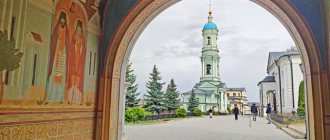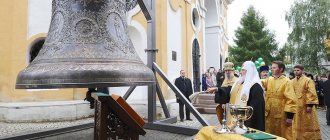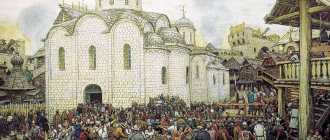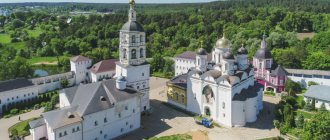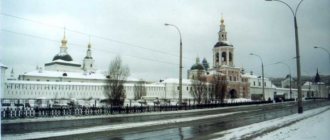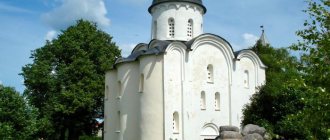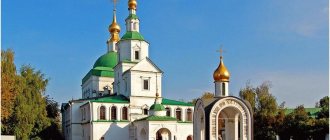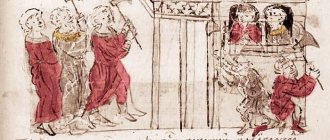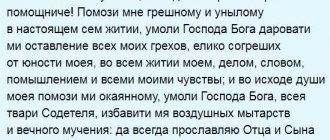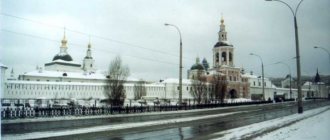Who was this man?
People are not born saints, they become saints throughout their lives, setting an example for others, tirelessly serving the Lord and doing good deeds with meekness and humility, without seeking worldly recognition and rewards for them.
Tryfon Vyatsky was such a person. His biography, on the one hand, is full of ambiguities relating to periods of wandering, but on the other hand, quite a lot is known about the saint.
By origin, Tryphon was a peasant, and by vocation, a servant of God. This man decided to devote his life to the Lord in his early youth. However, he acted in a very peculiar way. Instead of coming as a novice to the nearest monastery, the future saint set off on his first journey. There were many such trips in his life, so it can be said that he was a wanderer of God.
During one of these trips, a miracle occurred, considered the first, since it was recorded. Through Tryphon's prayer the child was healed. It is likely that this case was not the first, but no mention of earlier miracles has survived. Accordingly, in his life Tryphon was not only a wanderer of God, an ascetic or a blessed one, but also a miracle worker.
Features of the iconography of Saint Tryphon
Icon painters depict the Great Martyr in two variations. Some icons show Tryphon as a rider on a running white stallion. His left hand holds the reins, and on his right hand, raised high above his head, sits the royal falcon. At the top of the image you can see Jesus Christ blessing the saint. The saint wears blue clothes, and his shoulders are covered with a scarlet cloak.
In other images, the holy martyr is depicted standing, waist-deep. His pleasant face is turned to those praying, his left hand is pressed to his heart (sometimes he holds a cross with it), as a sign of love for the Savior, and a bird sits on his right.
When he was born? When did he die?
The future saint was born in 1546; no mention of the day and month has survived. His parents belonged to the peasant class and were very wealthy and very pious. Tryphon's father's name was Dmitry Podvizaev, he was a man of meek disposition, distinguished by fear of God and poor health. Information about the mother has not been preserved, which is not surprising, because in the 16th century the way of life was regulated by Domostroy.
The future saint was the youngest child in the family. They baptized him with the name Trofim. He was named Tryphon when he was tonsured. This man accepted monasticism at the age of twenty-two.
The wonderworker of Vyatka Tryphon died in October 1612, in the city of Khlynov, in the Assumption Monastery, which he founded.
Prayers to the Holy Great Martyr Tryphon
There are quite a lot of prayer requests to Saint Tryphon of Apamea. Each of them is read on specific occasions, depending on needs and circumstances.
About work
O holy martyr of Christ Tryphon, hear our prayer now and at every hour, servant of God (names), and intercede for us before the Lord. You once healed the princess’s daughter, who was tormented by the devil in the city of Rome: save us from his cruel wiles all the days of our life, and especially on the day of our last breath, intercede for us. Pray to the Lord, that we may also be worthy to be partakers of everlasting joy and joy, and that together with you we may be worthy to glorify the Father and the Son and the Holy Comforter of the Spirit forever and ever.
About marriage and happiness in marriage
O holy martyr of Christ Tryphon, quick helper and quick to obey the intercessor to all who come running to you and pray before your holy image! Hear now and at every hour the prayer of us, your unworthy servants, who honor your holy memory in this all-honorable temple, and intercede for us before the Lord in every place. You, saint of Christ, shining in great miracles, exuding healing to those who come to you with faith and intercede for people in sorrow, you yourself promised before your departure from this corruptible life to pray for us to the Lord and you asked Him for this gift: if anyone in any need, sadness and illness of soul or body, if he begins to call on your holy name, may he be delivered from every excuse of evil. And as you sometimes did to the princess’s daughter, in the city of Rome, tormented by the devil, you healed her, her and us from his cruel machinations, save us all the days of our lives, and especially on the day of our last breath, intercede for us. Then be our helper and quick drive away of evil spirits, and our leader to the Kingdom of Heaven. And where you now stand in the presence of the saints at the Throne of God, pray to the Lord, that he may grant us also to be partakers of everlasting joy and joy, and that with you we may collectively glorify the Father and the Son and the Holy Comforter of the Spirit forever. Amen.
From damage
O Saint Tryphon! O martyr of Christ! Hear now us servants of God (names) and intercede for us before the Lord. By your wonderful power you healed the royal daughter, who was tormented by the devil. So save us from the cruel wiles of the evil one. Pray to the Lord to keep us all the days of our life. And when the time comes for our last breath, pray to the Lord for us. So that he allows us to partake of his pure joy and joy. We glorify the Heavenly Father with you! Amen.
Skeptics often question the miracles performed by the holy martyr Tryphon. However, the stories of eyewitnesses who felt the full power of prayers say otherwise. The saint never refuses help to those who sincerely ask.
If you find an error, please select a piece of text and press Ctrl+Enter.
Asceticism and the first miracles
Tryphon began his wanderings in his early youth. He walked between villages, towns and villages. The future saint met his first confessor and mentor in Veliky Ustyug. Of course, this man was a priest, and his name was Father John. No other information about him has been preserved. Having been blessed by Father John, Tryphon remains for some time in Shomoks, a small volost near Veliky Ustyug. Here he works and leads a simple, peasant life.
After staying in Shomoks for some time, the future saint sets out on the road again. During his journey, he visits Perm, and then comes to a small city on the banks of the Kama. At that time it was called Orlov-gorodok. Now this is the village of Orel, located, of course, in the Perm region, in the Usolsky district. Here the future saint lives on the church porch and spends most of his time walking the streets.
During one of these walks, a significant incident happens to Tryphon. The Stroganovs' courtyard people joke about him. The joke is that the future saint is thrown off a cliff into the snowdrifts. However, repentance quickly comes to the courtyard people, they dig the wanderer out of the snow and are amazed at the absence of even a shadow of annoyance or anger in him. Of course, the jokers tell their household about the incident that impressed them so much, and the owner, Yakov Stroganov, becomes aware of the event.
He was a superstitious and God-fearing man. Having learned about the behavior of his servants, the very next day Stroganov came to the church porch, found Tryphon and asked his forgiveness. He also reported about the serious illness of his only son. The future saint and wonderworker of Vyatka Tryphon prayed for the child, and the Lord granted healing to Stroganov’s heir. This was the first miracle, information about which has reached the present day.
Having gone on to wander further, Tryfon comes to the village of Nikolskoye, located on the banks of the Viled River. Here the second miracle of healing occurs. The wife of clerk Maxim Fedorov, Ulyana, turns to the future saint with a request to beg the Lord for the healing of her two-year-old son. The Vyatka wonderworker Tryphon prayed all night and a miracle happened. The baby, who was on the verge of death, woke up healthy.
After this miracle, the future saint leaves his asceticism, since worldly glory weighs heavily on him. He comes to the village of Pyskor, located in the same Perm region, and turns to the abbot of the local monastery, Varlaam. Father Varlaam, of course, does not refuse the ascetic and tonsures him as a monk, naming him Tryphon.
At the beginning of the journey
The future mentor of monasticism was born around 1546 far from the Vyatka borders - in the “northern country called Mezen,” now the Mezensky district of the Arkhangelsk region. Once upon a time, here on the banks of the Nemnyuga River, just 60 versts from the White Sea, there was the village of Koneshelskaya, which is considered to be the birthplace of the saint. Today you can't find it on the map. Time has changed these places a lot. However, the saint’s birthplace has not been forgotten: at the beginning of the 18th century it was marked by a wooden chapel, which has survived to this day. Local residents call the chapel “Tryphon” and twice a year, in memory of the saint in October and on the fourth Sunday after Easter, they make a pilgrimage to it.
Little is known about the saint’s childhood and youth. His parents Dmitry and Pelageya Podvizaev were peasants and named their son Trofim. Soon the father died, and the boy, along with his older brothers, remained in the care of his mother. The Life does not tell us how the quest for monasticism was born and strengthened in the soul of the future ascetic. Whether it was a mysterious action of the grace of the Holy Spirit or whether it arose under the influence of conversations of the parish priest, meetings with residents of northern monasteries or pilgrims is not known. But soon he had to make a choice that determined his life path.
As soon as Trofim turned 17 years old, his older brothers decided to marry him. Having chosen a pretty girl from among the servants and dressed her in beautiful clothes, the brothers sent her to Trofim. But she, according to the word of life, although she “erased the sting of her tongue, she did not shake the strong pillar.” The girl’s “flattering and seductive words” did not confuse the young man. In the words of the hagiographer, “these brothers did not commit fornication for the sake of fornication, but as if to combine him in marriage and keep him in his fatherland in all abundance and abundance.” But it was this event that forced Trofim to make a choice: either start a family and increase the fortune of the family through labor, or leave this world and seek the Kingdom of God and its righteousness (Matthew 6:33) along the paths of monastic life.
This happened around 1564, when the Moscow kingdom stood on the threshold of the oprichnina, ready to leave a bloody stamp on the entire Russian world. A little time will pass, and the guardsmen will fall with particular cruelty on Novgorod the Great and its possessions in the Russian north, in which the Podvizaev family lived. Of course, it’s unlikely that Trofim’s relatives could have foreseen how quickly and tragically their lives would change, and therefore they wanted to keep the young man in his native village by any means possible. And only in this case could Trofim himself count on the support of relatives who lived in “contentment”. If he decided to leave his father’s house, then he completely surrendered himself into the “hand of God” (Wisdom 3:1). Even today this is not an easy step. Can we imagine what it meant to “leave your fatherland” in such difficult times? But God, from whom “man’s feet are straightened” (Ps. 36), confirmed Trophimus in his decision to leave his parental home.
The young man did not have the opportunity to become a novice at the Solovetsky Monastery or other famous monastery. The reason for this, as suggested by archpriest Andrei Dudin, a life researcher, could be the reverend’s humble origins. It is known that large and established monasteries in those years accepted mainly people from noble families, for the maintenance of which their relatives could make a significant contribution. Commoners often had to begin their monastic journey from small and recently created monasteries.
Trofim with the wanderer's staff headed to Ustyug the Great, which is almost seven hundred miles of travel. Here the priest of the Afanasyevskaya Church, John, took part in his fate, in whom Trofim found his spiritual mentor. The priest approved the young man’s desire not to marry and sent him to the town of Orel on the Kama River, which in those years was the unofficial capital of the Stroganovs’ vast domains. From that time on, for fifteen long years, the life of the young ascetic was connected with the Perm forests, which became for him a desert of his first monastic deeds and prayers.
Life in the Pyskor monastery and miraculous phenomena
In the Pyskorsky monastery, the future saint and patron of Vyatka Tryphon works diligently, stays awake at night, spending them in prayer, and surprises the brethren with meekness and the greatest humility of soul. He performed all the monastic work with joy, without laziness or grumbling.
In addition to caring for the good of the monastery, the future saint tirelessly tortured his flesh. He slept little and on the bare ground. He fasted tirelessly, never violated the cell rule, and on summer days he went naked into the courtyard and gave his flesh to midges, gadflies and mosquitoes. Tryphon stood all night among the clouds of insects, praying to the Lord.
Soon the future saint fell seriously ill. He lay there for forty days, after which Tryphon was shown two visions - an Angel sent by the Lord, and Saint Nicholas the Wonderworker. Nicholas the Pleasant, appearing to the monk, healed him.
After the recovery granted by God through the Great Wonderworker Nicholas of Myra, Tryphon’s ministry became even more diligent. And so it happened that people began to come to the monastery, exhausted from illness. Many healings occurred through the prayer of Tryphon, both children and adults who were possessed by demons.
The worldly glory of Tryphon was extremely great. Of course, this circumstance awakened envy and other dark qualities among the other monks. This weighed heavily on the future saint. One day, having prayed to the Lord, he left the monastery, having nothing with him.
Complete biography of the miracle worker
Despite the fact that the holy martyr lived in the 3rd century, almost his entire life, including his miraculous deeds, has reached us.
Holy Wonderworker Tryphon
Video “The Life and Miracles of the Holy Martyr Tryphon”
From this video you will learn about the life of the holy wonderworker Tryphon.
Childhood and adolescence
Historians cannot name the exact date of birth of the future saint. Presumably this is the 30-50s of the 3rd century. The boy was born in the small village of Kampsada (present-day Türkiye). His family lived poorly - his parents were ordinary peasants. The deeply religious mother and father raised the child according to Christian traditions, despite the idolatry being spread around. However, as he grew older, young Tryphon’s faith did not prevent him from making friends with his pagan peers.
One day, when the children were playing in the yard, one boy was bitten by a snake. The adults came running in response to the loud crying, but no one knew what to do in such a situation. Since everyone considered Tryphon not of this world, they asked him to offer a prayer over the victim. He prayed for a long time, and soon his friend began to recover.
Having matured, the boy was forced to earn his own living. Since he had no education, he went to his rich neighbors and in exchange for food helped them cultivate their fields, build houses, and herd livestock. Sometimes, remembering that incident of miraculous healing, fellow villagers turned to the boy for help. Tryphon never refused to those in need, and somehow even saved the harvest from an insect invasion.
Over the years, the young man spent more and more time reading prayers, gradually renouncing worldly life. The Lord gave him the ability to cast out demons, and the boy was once able to help the possessed daughter of Emperor Gordian. The devil, sensing the miracle worker approaching the palace, himself left the body of the young girl. For six days Tryphon offered prayers to the Almighty, observing strict fasting, and on the seventh Satan finally appeared to him in the guise of a terrible big dog.
Life Tests of Faith
Living during a time of severe persecution of Christians, the young saint did not escape a tragic fate. The word of Emperor Decius ordered the arrest of the preacher, but he did not think of hiding.
To carry out the trial, the prisoner was sent to Nicaea, but Tryphon did not renounce his faith, continuing to bring the Word of God to the local residents. For such insolence he was sentenced to torture - he was hung upside down on a thick branch and beaten with sticks for a long time. A few days later the torment continued. This time they drove metal hooks into his flesh, burned him with fire, and nailed his legs.
But the tormentors failed to extract words of repentance from the monk. Despite the terrible pain, he continued to read the Psalter loudly when an angel appeared before him holding a crown. Seeing this miracle, the emperor became even more furious and ordered the sufferer’s head to be cut off. By the will of the Lord, the execution was not carried out - the great martyr died suddenly.
Tryphon of Apamea always helped those in need
Hermitage and conversion of pagans to the faith of Christ
Walking along the Kama, Tryphon found an old abandoned boat. He got into it and floated with the flow. Not far from the mouth of the Mulyanka River, Trifon Voice heard him pointing out a place on the bank. In that clearing there was an ancient Ostyak temple, a pagan sanctuary in which sacrifices were made to idols. Tryphon settled as a hermit near him.
The elder of the Ostyak community, whose name was Zevenduk, sent about seventy armed men to the hermit. Tryphon preached to them the faith of Christ and explained to them about their idols. People left the hermit in confusion and, of course, told everything to the local prince, whose name was Ambal. He expressed a desire to see the hermit with his own eyes and listen to him.
However, events did not develop peacefully. The hermit was visited by the merchant Sukhoyatin, who conducted trade business with local pagan tribes. He left Tryphon an ax and, probably, some other things necessary for life. The hermit decided to use them to destroy the temple and all the gifts to pagan idols, in which he succeeded. Having learned about this, Ambal and his people came to Tryphon and were amazed at how this man could destroy their ancient sanctuary without getting hurt.
Although Ambal himself did not revile the saint and was not angry with him, many Ostyaks burned with a thirst for revenge. Just at this time, the Cheremis tribes went to war on their lands. The Ostyaks were very afraid of them, and their fear was especially great because of the confidence that the hermit would point out the location of the dwellings to the enemies. But when they went to kill Tryphon, they could not find his hut-cell. The saint himself was praying in it at that time, not hiding from his fate.
This miracle served as an impetus for the Ostyaks to accept the faith of Christ. New converts often came to the hermit, listened to his sermons and brought him gifts - honey, food, furs and much more. Worldly glory overtook Tryphon again. After some time, he left his cell and returned to the Pyra monastery.
Icons and temples of the martyr
Icons of Tryphon of Apamea can be seen in many cathedrals and monasteries. Copies of the images are freely sold in church shops, and you can light a candle to the great martyr in any Orthodox church. The saint's feast day is February 14.
The falcon, which is depicted in the images, is the personification of one of the miracles performed by the saint. One day, boyar Patrikeev, being an imperial falconer, went hunting with the tsar. He did not keep track of the bird, and it flew away, for which the evil ruler promised severe punishment if the loss was not found. The man, who had lost all hope, turned to the miracle worker for help. In a dream, the saint came to him and showed him where to look for the falcon. Later, a small church was erected on this site. Today there is the famous Moscow Cathedral of the Sign of the Blessed Virgin Mary (38 Trifonovskaya Street, not far from the Rizhsky Station), where you can venerate parts of the relics of the saint.
The ark with the head of the martyr is located in the temple of the city of Kotor (Montenegro), built in the name of the saint.
Icon of Tryphon of Apamea
Founding of the Assumption Monastery and canonization of Tryphon
Returning to the Pyrsky monastery, the future saint Tryphon of Vyatka led a simple life. Although rumor spread the news of the miracle worker’s return to the walls of the monastery, Tryphon did not leave his cell, except for those moments when it was necessary, and spent days and nights in prayer and comprehension of the Holy Scriptures.
Soon Tryphon left the monastery again and retired to the lands of the Stroganovs, on a mountain near the Chusovaya River. However, people came here in an endless stream and not all of them really felt the need for help. The future saint lived in these lands for nine years, and left them at the request of Grigory Stroganov.
Having left the Stroganovs' possessions, Tryphon went to his spiritual mentor, Father Varlaam. I shared with him my thoughts that there is not a single monastery in the lands of Vyatka. Having received Varlaam’s blessing to found the monastery, the future saint set off on a long journey, in which he had a vision of the place where the monastery should be built.
On March 24, 1580, the Metropolitan blessed the foundation of the monastery and ordained Tryphon to the priesthood. And on June 12 of the same year, Tsar John Vasilyevich gave a special letter for the arrangement of the monastery, adding bells and liturgical books to it.
The construction itself proceeded with significant obstacles until one of the local peasants saw a vision of the Mother of God in a dream, indicating the location for the temple. Thus, the Church of the Annunciation of the Blessed Virgin Mary was founded, and things immediately went smoothly with the arrangement of the new monastery. Soon the small monastery became cramped and it was expanded, establishing a large Church of the Dormition of the Mother of God. Nowadays, this church is the Assumption Cathedral of the Trifonov Monastery and the relics of the Vyatka saint rest in it.
The miracle worker of Vyatka was canonized by the decision of the Holy Synod only in 1903, in the person of the venerable one. His memorial day is October 21st according to the Gregorian style. We honor Saint Tryphon of Vyatka throughout Rus'. But this saint enjoys special love and respect among the residents of the Vyatka and Perm regions.
A million torments of Tryphon Vyatsky
Venerable Tryphon of Vyatka
Biography of Trifon Vyatsky, named V.A. Berdinskikh, “the devout, active and stern founder of Vyatka monasticism,” despite the formal presence in it of all the key episodes of the canonical life, is still characterized by a purely individual plot outline and a special theological understanding of the psychology of holiness, the place of the saint in the world of people and state relations. This is apparently due to the peculiarities of the structure of the internal world of Tryphon himself. First of all, the following characteristic features of his spiritual portrait draw attention - prayerful boldness and spiritual directness. The combination of these two qualities makes the reverend a miracle worker during his lifetime and at the same time calls upon him a whole avalanche of temptations, persecutions and troubles, since every miracle must be paid for, not only in advance (by a virtuous life and righteous works for the good of the Church), but also by interest, growing over time, according to the laws of geometric progression (envy of like-minded people, demonic intrigues, visible and invisible spiritual warfare). Of course, when reading the Life, we come into contact with the personality of the monk indirectly - through the prism of her perception by the hagiographer, but even so we can understand and feel the spirit that rejected the very possibility of tranquility, which permeated the many-sided and varied activities of this nugget.
Tryfon (baptized Trofim) was the son of an ordinary Mezen peasant and from childhood he breathed the same invigorating frosty air of the freedom-loving Pomors, which raised another talented restless northerner named Mikhail a century and a half later. And if for Lomonosov the most powerful social lift was education and the career of a scientist, then the example of the Monk Tryphon (and not only him) showed that in the second half of the 16th century, in order to get out among the people, to gain access to the tsar and patriarch, an ordinary and poor person could seek success in the field of monastic work. It seems that not the last psychological reason for the conflict that arose between the monk and his disciple Jonah was the arrogant reluctance of the latter (“who came from honest Moscow nobles”) to be in obedience to a simpleton, as they say, from the plow, although in the case of Tryphon it would be more correct to say “from seine."
The most amazing thing in the life of Tryphon is how early he begins to work miracles
Perhaps the most amazing thing in Tryphon’s biography is how early he begins to work miracles. Traditionally, the life of the saint includes only a few signs during his lifetime, usually related to the economic development of the monastery (drawing a spring, providing food for the starving brethren, etc.), but ends with a significant list of posthumous miracles. Lifetime healings through the prayers of the monk are described by hagiographers, as a rule, with great caution. The narrative in the Life of Tryphon is structured completely differently.
As a young man of about twenty, Trofim meets the merchant Jacob Stroganov in the church of the city of Orlov, who, recognizing him as a faithful servant of God (“seeing the blessed youth in the church standing with the fear of God and diligently praying”), turns to him with a request to pray for his seriously ill son : “I demand your holy prayers, so that you may be an intercessor and prayer to God for me and for my son.” Tryphon, although he denies his ability to heal a dying child (“Man, this thing, you say about him, is not ours, but God’s”), begins to pray, and his prayer is heard: “his son Maxim was freed from bodily sorrow, and God kept them all the days of their life.” What makes a “novice” ascetic, not a monk, not an elder, not a learned theologian, but a simpleton and a peasant, a miracle worker? How did the young man Trofim manage to acquire such grace? The answer is given by the Life itself - the saint had just suffered mockery and beatings from Stroganov’s servants, who, laughing at his appearance as a beggar wanderer, threw him off the high bank of the river (“I see the blessed stranger and stranger and praise // (l. 56 vol.) tivshe him, swearing, and vergosha in the foothills to the river"). Finding himself in a severe frost in shabby and patched clothes in a snowdrift, Trofim with meekness and words of blessing meets the offenders who came down to dig him out. Stroganov himself knew about what happened. Was it not this incident, more than the pious appearance of the monk, that prompted the merchant to turn to the prayerful help of the poor boy? Be that as it may, Stroganov, like any other Russian, knew that the Lord listens to the poor and offended, the sorrowful and selflessly meek, in a word - the Lord most likely listens to the prayer of the blessed, holy fools, in whose guise he appeared in the Perm land young man Trofim[1].
The price of good deeds is the “millions of torments” that the righteous endures
Trophim, and later Tryphon, continues to work miracles throughout his life, becoming a true healer of the ailments of those villagers who live near his cell and - later - near the monasteries he founded, however, at the cost of these benefits, generously squandered by the monk around him, truly that “million torments” that the righteous man endures on his life’s path, and the monk himself, who wrote the original autobiographical notes, later revised by his hagiographer, could have entitled his work “The History of My Disasters.”
Tryphon's taking of monastic vows and the school of monastic practice he underwent in the Pyskorsky monastery - these most important milestones in the life of every monk - resonate in his biography with a terrible illness, helpless powerlessness and even temporary death: “And if at that time the brethren were in the monastery and saw The venerable one lies so silently, they would think he was dead.” However, having survived an untimely death, during which the monk, together with his guardian angel, leaves the earth (“I imagine the venerable one flying in the wake of the angel, and in vain the venerable one, and not seeing either heaven or earth, but just an indescribable light”), Tryphon still returns to the mortal world of temporary life: suddenly the angel hears a cry from above: “I hastened to take him this way, but return him back to where he was.” It seems that what must be done by the monk in the present period of his life is so great and saving that demonic forces, taking advantage of the ordinary sinfulness of human nature (“I lie as the venerable one, weeping and weeping... grieving for my sins”), strive to destroy the righteous man, attract sorrow and illness to him before he has time to embark on the road of monastic construction. However, through the prayers of St. Nicholas, whose life and exploits he will honor until the end of his days, Tryphon is healed.
Pyskorsky Spaso-Preobrazhensky Monastery in our time
The motif of glory spreading about a monk in the monastery of tonsure is traditional for monastic hagiography, but this motif does not always develop in such a conflicting direction as it does in the Life of Tryphon: “Netsy and the living from those living in the monastery of this commandment of the devil were indignant at the venerable and certain blasphemy verb." Apparently, the directness of Tryphon’s character, his spiritual simplicity, his inability to play behind the scenes games in such a psychologically complex group as the monastery, and most importantly, the ongoing miracles that arouse the envy of the brethren lead to a serious intensity of passions. That is why the monk, who in general throughout his life never gave up his love of travel, decides to leave the monastery of the monastery and settles as a hermit near the bank of the Nizhniye Muly River.
Tryphon's massacre of the spruce evokes awe
Here the image of the monk temporarily takes on the features of an enlightener of Gentiles: Tryphon begins to preach to the Ostyaks; armed with prayer and fasting, he cuts down the fir tree sacrificed to idols, which previously punished with death anyone who touched it, and converts the daughters of the Ostyak princes to Christianity. The psychology of foreigners is interesting: the first surprise caused by the sight of a lonely black who settled within their borders and leads a strange and incomprehensible way of life for them, is replaced by genuine interest, and then by making inquiries with representatives of the civil authorities. Stroganov’s clerk Tretyak Moiseev, to whom the pagans turned, assures Prince Ambal of the saint’s trustworthiness: “I know this man, about whom you say, that he is a holy man, and who teaches you to believe in Our Lord Jesus Christ, you are from him.” do everything commanded to you.” Tryphon's massacre of the spruce evokes awe. It seems that part of the reverence that the sacred tree accumulated on itself passed in the eyes of princes Ambal and Zevenduk to Tryphon, who cut it down: “And Prince Ambal’s speech to the saint was not like reproaching or reproaching, but in a quiet voice and with the meekness of the saint asking, saying to the face: “I marvel.” , elder, to your task, how can you destroy this tree//(l. 103), it is our fathers and for them we, like God, reverence.” However, the reverent respect of the children of nature is soon replaced by a suspicious assumption about possible spying on the part of the monk, which prompts them, in the conditions of the approaching campaign of the Cheremis, to seek his death. “So they thought about the life of the one punishing them,” the hagiographer mournfully notes in this fragment. However, the Lord miraculously shelters his saint from the hands of murderers, and soon the monks of the Pyskorsky monastery come to the monk with a request to return to the monastery he left and became orphaned without him.
What was the reason for the brethren coming to the monk to confess? Repentance for what they had done and grief over separation from their spiritual father, similar to that which gripped the inhabitants of the Trinity Monastery after Sergius left for Kirzhach? However, there was no repentance or sorrow, there was only awareness of one’s economic insolvency and material shortage: the glory of St. Tryphon attracted to the monastery not only crowds of suffering pilgrims who asked him for prayers, but also rich offerings, the flow of which dried up with Tryphon’s departure. To add insult to injury, the salt pipe, the monastery’s most important source of income, became hopelessly clogged. The situation was depressing - it was necessary to save the farm, without which the monastery would not survive. That is why arrogant lovers of showing the young man (after all, Tryphon was not even 30) his true place had to save the manifestations of their ambition until better times... And Tryphon returned, repaired the pipe, again began to heal the blind and crippled - exactly until the passions had subsided did not flare up with renewed vigor.
This time, Tryphon retires to the possessions of Yakov and Grigory Stroganov on the Chusovaya River. Having received “a place in their abode for himself,” the monk through prayer casts out the demon that had settled on him and builds a chapel of Sophia of the Wisdom of God. And again, very soon a folk trail of the surrounding peasants grows to the cell of the prayer book. It seems that the lonely, semi-hermit life of the monk excludes the possibility of persecution from the envious brethren, but trouble, another torment, comes from a direction from which Tryphon could not have expected. At that moment when the monk “began to cut down the forest for sowing grain, wanting to eat from his labors,” a gust of wind that suddenly flew into the place of his exploits transfers the fire with which Tryphon was scorching his cutting to the wood reserves of the surrounding peasants and Grigory Stroganov: “ and the fire even reached the firewood that had been set up by the living villagers, //(l. 130) which had been set up for the sake of the Stroganovs’ salt trade, and a lot of that wood was burned.” Seeing this, the enraged residents, as they themselves later assured “in the sorrow of our hearts,” grabbed the monk “and from the heights of the mountains threw him down on a sharp stone.” Having survived the fall, Tryphon, fleeing, reaches the river bank and jumps into a randomly empty boat, which “so easily” ferried him to the opposite bank.
Like a baby, crying, looking for his mother, so Tryphon, crying, looking for the Vyatka country
The angry farmers grabbed Tryphon later, when the first animal rage had already passed, and brought him bound to Stroganov. He, in turn, replenished the cup of suffering of the righteous with imprisonment. However, a short time later, the merchant, punished for cruelty, will free Tryphon, setting him a condition - to leave the Perm borders forever. Tryphon himself, bidding farewell to his well-wishers (of which, be that as it may, there were always many, no matter what blows of fate fell upon the saint), remarks: “this place is from your master in oppression.” So, “necessarily” and through force, involuntarily and in suffering, the monk found his true spiritual homeland - the Vyatka land, about which one of the heroes of the Life would later say so poetically and heartfeltly: “Like a baby, crying, looking for its mother, so this Venerable Tryphon, weeping, searches for the Vyatka country and weeps spiritually over the separation of the Vyatka monastery of the Dormition of the Most Holy Theotokos, which he created, since he wants to rest his body in it.”
That part of the Life that describes the establishment of the Assumption Monastery by the monk, in a new way, completely different from the earlier Lives, describes the mechanism of the organization of the monastery. In his administrative and economic undertakings, the monk relies not on the assembly of monastics (as already said, Tryphon did not at all have the competencies vital to manage a group of monks), but literally on the people of God, the laity who treat him with sympathy and trust, and, of course , representatives of the authorities (merchants Stroganov, governor Vasily Ovtsyn), who repeatedly throughout his life provided him with significant patronage.
Realizing that the Vyatka land is deprived of monasteries and comprehending this fact as a regrettable misunderstanding, the monk turns to the simple Vyatchans, who “all five cities” write a petition to Moscow about the establishment of the monastery: “And having written // (l 147 vol.) Petitions from all five cities for the priests, and for the judges, and the zemstvo elders, and the kissers, and all Orthodox Christians, and for their spiritual fathers, and sent the venerable one to Moscow to the Tsar and to the Right Reverend Metropolitan to beat him with his forehead.” So, if earlier the establishment of a monastery in a deserted place led to the establishment of a settlement behind its wall, and thus the colonization of new, mainly northern lands took place, now the lands developed without church intervention needed, on the contrary, spiritual development - sanctification by the life and feat of monks.
Dormition of the Blessed Virgin Mary Trifonov Monastery
The life describes in detail Tryphon’s labors to ensure the economic prosperity of the monastery he founded: his trips to Moscow to the Tsar and Patriarch, his appeal to the governor Vasily, the transfer of an unfinished church to a new location, the addition of “villages, and people, and lakes, and hayfields” to the monastery. . All this, in the opinion of the hagiographer, is clear evidence of the saint’s holiness, material signs of a perfection beyond the material dimension, crowned in the end with the rank of archimandrite: “then he receives a blessing from the most holy Job the Patriarch, and by the laying on of his holy hand he is appointed archimandrite.”
The Vyatka region has not had such a large-scale and successful local politician for several centuries
However, at the moment of the apogee of the saint’s worldly glory, when he achieved all possible successes along the career ladder of the Russian Orthodox Church (“Perhaps, the Vyatka region has not had such a large-scale and successful local politician for several centuries”[2]), when, it would seem, Tryphon everything he planned succeeded, a crisis turning point in the fate of the monk comes: the economic prosperity of the monastery, which he had so persistently sought for many years, ultimately turns into the unbridledness of the brethren, who refuse to live according to the charter adopted by the monk, limiting the satisfaction of their sinful whims. The monks want to keep “intoxicating drink” in their cells and invite lay people to the monastery to organize joint feasts.
What was Tryphon's reaction? “The venerable one, like a solid adamant, abiding even without order//(l. 184) did not at all heed their advice, but above all said quietly: “It is worthy for us, brothers, according to the tradition of the saints, that the father of all, together for the meal, will be pleased that God and the Most Holy The Mother of God will give, and then on time. But we are not commanded to have drunken drink from anywhere.” Tryphon’s “Adamantine” firmness correlates, as we see, with his personal vision of the situation, mental disagreement to bless the storage (and, in fact, consumption) of intoxicating drink in the monastery, at the same time, in refraction to the brethren, this fortress turns into “quietness” and meekness, in fact - obvious lack of a certain kind of charismatic rigidity in the ability to defend one’s rightness.
Monument to Tryfon Vyatsky
The seditionists not only do not heed the gentle admonitions of the elder, but also remove him from the abbotship of the monastery he founded, choose his disciple Jonah Mamin as archimandrite and continue to inflict all sorts of insults on the monk: “I was angry with malice and wanted to insult him with beating, but also the church keys and took other services from him and drove him out of the monastery.” Jonah assigns to Tryphon a certain servant “very malicious”, who “with ridicule... and reproaches reproached him, and always barked like a dog, with foul language, and not only // (l. 192) evil-tongued actions, but also with his hands against the holy anointed head of daring happened, and was thrown into prison with the venerable one.”
An example of patience - the monk who suffered beatings from his disciples
Before us is truly an example of the unprecedented patience of a monk who was humiliated, insulted, and even suffered beatings from his own disciples. Of course, the Monk Paphnutius Borovsky was beaten by Metropolitan Jonah, but he was a metropolitan, the first person in the church hierarchy, albeit not entirely canonically elected; then, when one (only one) of the brothers decided to grumble about the rules of his monastery, Paphnutius appeared to the seditious man in a dream and uttered only two words, “This blasphemer,” but in such a tone that the dissatisfied man completely lost the desire to blaspheme.
The Monk Tryphon, despising all pride, endures insults and blasphemies, finds himself imprisoned in his own monastery, until finally Jonah drives him out, which in fact turns out to be the most terrible of all possible executions for the elderly elder: “Like a baby, crying, looking for his mother, so this Venerable Tryphon, weeping, searches for the Vyatka country and weeps spiritually over the separation of the Vyatka monastery of the Dormition of the Most Holy Theotokos, which he created, since he wants to rest his body in it.”
Despite the tragedy of the current situation, the monk does not despair and does not give up; moreover, one gets the impression that this titan of spirit is simply incapable of losing heart; on the contrary, he continues the vigorous activity of a builder and organizer. Soon, a new monastery and two churches appeared in the suburban city - Epiphany and Archangel Michael, erected through the efforts of Tryphon. However, Tryphon still cannot help but yearn for his beloved brainchild - the Assumption Monastery.
Having established a new monastery, Tryphon travels in search of funds to support its economic activities. And in these wanderings, a meeting occurs that reveals seemingly paradoxical behavior on both sides: the monk enters the house of Nikita Stroganov, who in a rage drives him out, despite the fact that Nikita’s brothers greet the monk complacently. This fact, however, does not prevent Tryphon from again turning to Nikita the next day with an insistent request to ensure “the construction of a new monastery, and books, and vestments, salt, iron, and other needs.”
The fact is that we have before us a typical plot mystery, which is resolved by breaking the linearity of the plot: by inserting a story within a story into his narrative, Tryphon’s hagiographer draws the reader’s special attention to the psychological reason for Tryphon’s course of action, which caused Nikita Stroganov’s undisguised anger.
Nikita, having once learned about the sad fate of the monk and his expulsion from the monastery by the disciple Jonah, who, according to his information, achieved the rank of archimandrite through the cunning of a courtier, out of heartfelt compassion begins to provide Tryphon with patronage: “And this, Nikita, having been in Moscow, went to the cathedral church and to the sovereign king // (fol. 201 vol.) and to the most holy patriarch the Venerable Tryphon beat his forehead for him and asked him to come to him, so that he would create a place of peace... And I begged him with honor, and brought him to this city of Salt Vychegotskaya in Vedenskaya monastery of the Most Pure //(l. 202) Mother of God, and built him a special cell, and for his cell rule he gave him a holy monk, so that he prays to God in his cell.” However, Tryphon did not stay long at government grub under the wing of his dignitary benefactor - soon the monk began to ask to go on a pilgrimage trip to Solovki. In general, according to the observation of V.A. Berdinskikh, “a close connection and then a break with the Stroganovs at this stage is very indicative of an proactive, seeking and independent spiritual leader,” who “did not curry favor with the Stroganovs, but used their help in every possible way for his own purposes”[3]. Having received a ship, food and workers at his request, Tryphon left Solya Vychegotskaya to sell the ship, distribute food and send off with God the people hired by Stroganov, “but according to his custom, he reached the Solovetsky monastery and, Having stayed there a little, and again from there, and came to Vyatka.” If this is not a provocation, then what is it? Why does the reverend so clearly provoke the wrath of his patron? “Tryphon yearned for his will, thirsted for new spiritual exploits,” [4] a modern researcher will write about the psychological background of this act of the monk. However, yearning for freedom and thirsting for new spiritual exploits, it was not at all necessary to cause significant material damage to the generous benefactor, or, as we would say now, it was not worth “throwing money” at a person whose entire professional activity was largely reduced to making money. No, this psychological paradox in the behavior of the monk hides something else, fundamentally different from a simple love for restless wanderings.
It would be useful here to recall some features of Tryphon’s biography that influenced his psychological portrait. One of these becomes, according to V.V. Potapova, the early death of the reverend’s father, the search for a spiritual replacement for his father in the person of a priest and, as a direct consequence of this, the fact that “the church becomes a spiritual home, a place of ideological throwing, problem solving” [5], as well as a certain kind of defenselessness of the reverend, the absence that courageous firmness of character that is instilled in childhood and adolescence by none other than the father. Hence many of the excesses in the character of the monk, whose spiritual structure, apparently, required anxiety and sorrow. We find certain characterological similarities in the biography of another fatherless person - St. Hilarion of Suzdal, who, like the Monk Tryphon, experienced the despotism of his elder brothers and in torment gained the freedom of monastic feat, that is, he experienced a certain kind of difficulty with the ability to defend the decisions made.
The soul of the saint, perhaps not even fully consciously (thus, according to I.M. Osokin, Tryphon’s well-known activity in enlightening the Ostyaks was of an accidental nature and was not the result of a deliberate plan [6]), but nevertheless persistently sought to overcome the tempting dangers , ambitious challenges. (What did the noble felling of the Ostyak tree cost?!)
My cherished dream is to die within the walls of the Assumption Monastery
Amazing in its lyricism, which only those readers of the Life who managed to penetrate into the secret of the character of the monk will be able to fully appreciate, the final chord of this symphony is the picture of an old man, exhausted in his deathbed illness, lying at the bottom of the “karbass” and sending messengers to the unmerciful disciple with a request to have mercy and accept him to the monastery. And in the light of the final fulfillment of this cherished dream - to die within the walls of the Assumption Monastery - it becomes not at all so important that Jonah, who ended his life by suicide five years later[7], agreed to accept the teacher under the shelter he created not immediately and not of his own free will , but driven by vanity and pressure from wide circles of the church community: not being strong in the internal monastic behind-the-scenes struggle, “Tryphon managed to gain serious support from the capricious and unstable city society in its opinions”[8]. This is not important, what is important is that Tryphon’s cherished dream was fulfilled, and the monk’s will to appoint Jonah as abbot upon his death (and the wait was very short) in this light seems to be the crown of all-forgiving love, and not at all a manifestation of spinelessness.
The life of St. Tryphon is a monument as interesting, non-standard as it is complex, multidimensional, and the image of the saint combines contradictory features - power and at the same time weakness, determination and inability to stand up for one’s rightness. Without a doubt, the Life of St. Tryphon only opens the treasury of its meanings - both Christian and universal - to its potential reader.
Architecture
The exterior of the main Assumption Church is simple and modest, the facade is divided into parts with large decorated walls. In the interior there is a painting on the theme of the Gospel; a relatively new painting illustrates the deeds of the venerable founder Tryphon. The main decoration of the Assumption Church is the five-tiered iconostasis, which is a brilliant example of the highest professionalism of local craftsmen. Father Theodore (Rulev) has served as viceroy since 2012.
The gateway St. Nicholas Church has a typical compositional design. The cubic base is raised on a high foundation, with a refectory and an apse on the sides. The facades of the building are distinguished by their artistic approach to decoration. The slender and graceful structure is complemented by fraternal cells and the abbot's building. This proximity gives additional solemnity when entering the territory.
In the southwest of the complex is the Three Saints Cathedral. Its pillarless quadrangle complements the altar part, the composition is completed with an onion dome. The facades are decorated in the “patterned” style of the 17th century; decorative brick passages and window casings add splendor to the exterior. Today the community is collecting donations to restore the interior of the Church of the Three Saints.
The Annunciation Church is the very first building on the territory of the Trifonov Monastery.
Annunciation Church of the Vyatka Assumption Trifonov Monastery
The building is made in the spirit of townsman architecture, has a pentagonal altar, a massive quadrangle and a refectory; along the central axis there is a vestibule, reminiscent of a blind porch. The shape of the facades combines elements of “patterned” and Peter the Great baroque. Today the building is in need of reconstruction.
